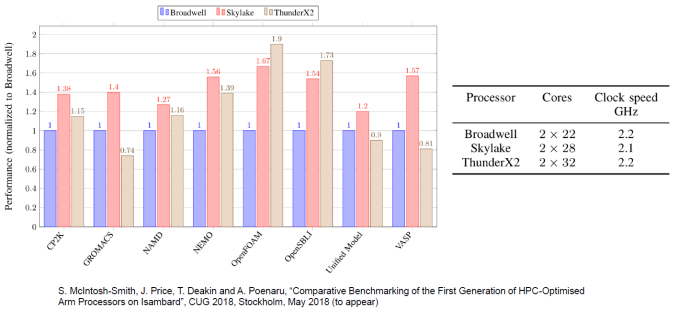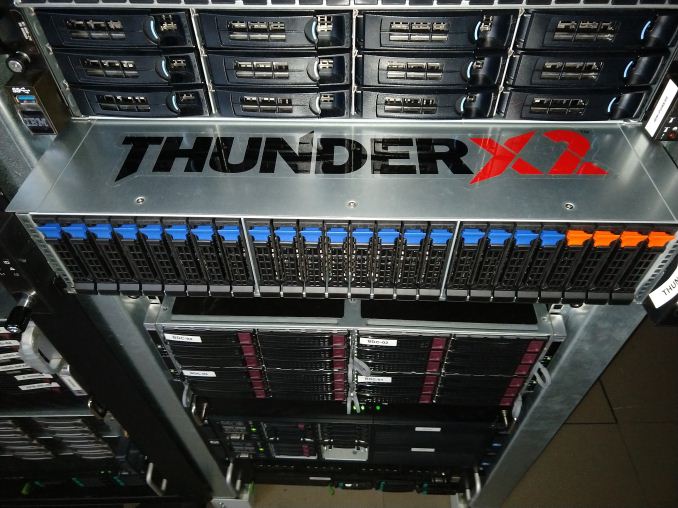Assessing Cavium's ThunderX2: The Arm Server Dream Realized At Last
by Johan De Gelas on May 23, 2018 9:00 AM EST- Posted in
- CPUs
- Arm
- Enterprise
- SoCs
- Enterprise CPUs
- ARMv8
- Cavium
- ThunderX
- ThunderX2
What We Can Conclude: So Far
Wrapping things up, our SPECInt analyses show that the ThunderX2 cores still has some weaknesses. Our first impression is that branch intensive code – especially in combination with regular L3-cache misses (high DRAM latency) – run quite a bit slower. So there will be corner cases where the ThunderX2 is not the best choice.
However, other than some niche markets, we are pretty confident that the ThunderX2 will be a solid performer. For example, the performance measurements done by our colleagues at the University of Bristol confirm our suspicion that memory intensive HPC workloads such as OpenFoam (CFD) and NAMD.run really well on the ThunderX2
From the early server software testing we have done so far, we can only be pleasantly surprised. The performance-per-dollar of the ThunderX2 in both Java Server (SPECJbb) and Big Data processing is – right now – by far the best in the server market. We have to retest AMD's EPYC server CPU and a Gold version of the current generation (Skylake) Xeon to be absolutely sure, but delivering 80-90% of the performance of the 8176 at one fourth of the cost is going to very hard to beat.
As an added benefit to Cavium and the ThunderX2, here in 2018 the Arm Linux ecosystem is now mature; specialized Linux kernels and other tools are no longer necessary. You just install Ubuntu Server, Red Hat, or Suse, and you can automate your deployments and software installation from the standard repositories. That is a massive improvement compared to what we experienced back when the ThunderX was launched. Back in 2016, simply installing from the regular Ubuntu repositories could cause problems.
So all in all, the ThunderX2 is a very potent contender. It might even be more dangerous to AMD's EPYC than to Intel's Skylake Xeon thanks to the fact that both Cavium and AMD are competing for much of the same pool of customers considering switching away from Intel. This is because the customers who have invested in expensive enterprise software (Oracle, SAP) are less sensitive to cost on the hardware side, so they are much less likely to change to a new hardware platform. And those people have been investing the past 5 years in Intel as it was the only option.
That in turn means that those who are more agile and cost sensitive, such as hosting and cloud providers, will now be able to choose an Arm server CPU alternative with an excellent performance-per-dollar ratio. And with HP, Cray, Pengiun computing, Gigabyte, Foxconn, and Inventec all offering systems based upon the ThunderX2, there isn't a shortage of quality vendors.
In short, the ThunderX2 is the first SoC that is able to compete with Intel and AMD in the general purpose server CPU market. And that is a pleasant surprise: at last, an Arm server solution that delivers!












97 Comments
View All Comments
JohanAnandtech - Thursday, May 24, 2018 - link
I have been trouble shooting a Java problem for the last 3 weeks now - for some reason our specific EPYC test system has some serious performance issues after we upgraded to kernel 4.13. This might be a hardware/firmware... issue. I don't know. I just know that the current tests are not accurate.junky77 - Thursday, May 24, 2018 - link
What? A 2.5GHZ ARM core is around 60-70% of a 3.8GHZ Skylake core?? For 3.8GHZ, the ARM is probably at least as fast?Wilco1 - Thursday, May 24, 2018 - link
Probably around 90% since performance doesn't scale linearly with frequency. Note these are throughput parts so won't clock that high. However a 7nm version might well reach 3GHz.AJ_NEWMAN - Thursday, May 24, 2018 - link
If Caviums tweaked 16nm hits 3GHz - it would to be unreasonable to aim for 4GHz for a 7nm part.With 2.3 times as many transistors available - it will be interesting to see what else they beef up?
HIgher IPC? 64 cores? 16 memory controllers? CCIX - or perhaps they will compete with Fujitsu and add some Supercomputer centric hardware?
AJ
meta.x.gdb - Thursday, May 31, 2018 - link
Wonder why the VASP code limped along on ThunderX2 while OpenFOAM saw such gains. I'm pretty familiar with both codes. VASP is mostly doing density functional theory, which is FFT-heavy...Meteor2 - Tuesday, June 26, 2018 - link
All I want to say (all I can say) is that Anandtech has some of the best writers and commenters in this field. Fantastic article, and fantastic discussion.paldU - Saturday, July 7, 2018 - link
A typo in Page 2. "it terms of performance per dollar" should be " in terms of performance per dollar".